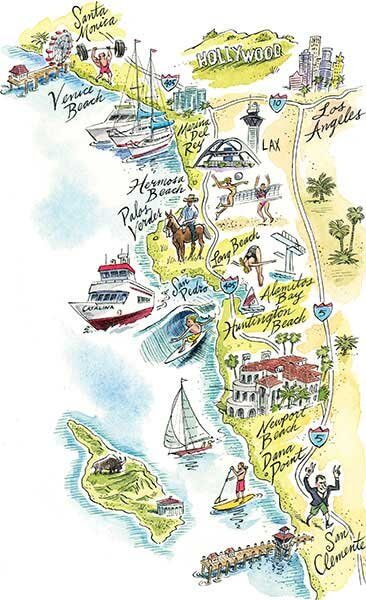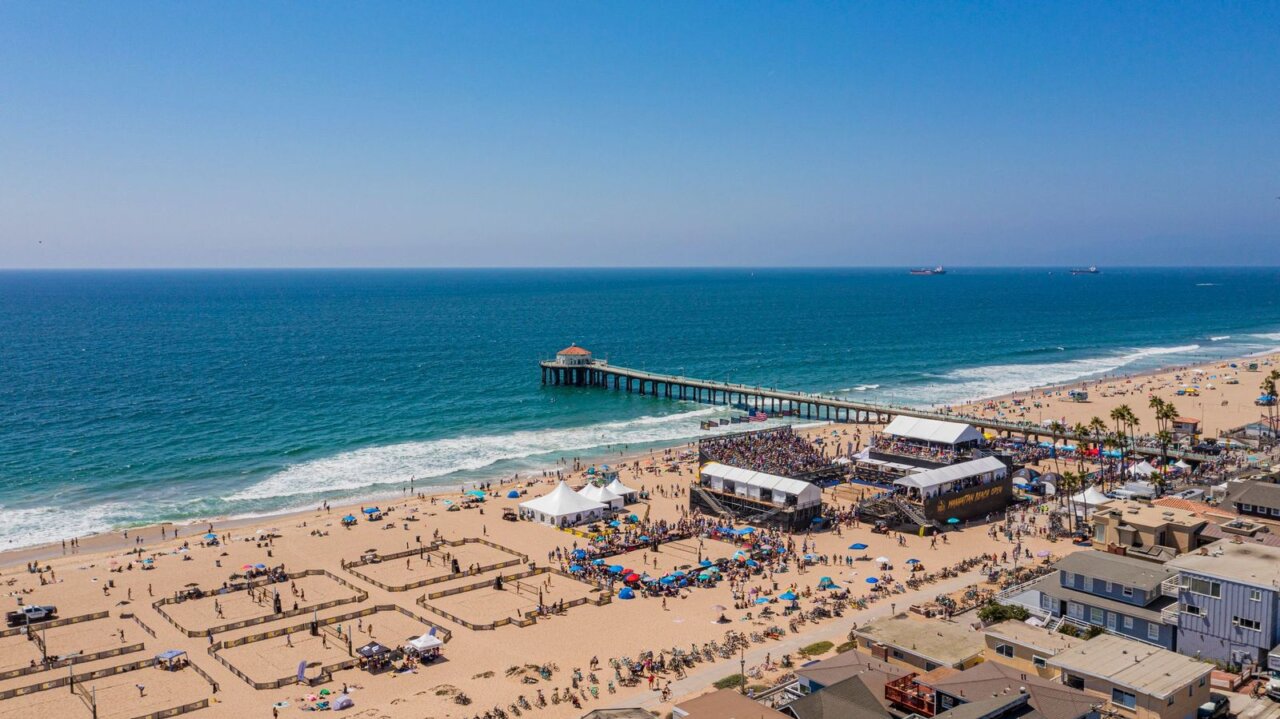Updated on April 25, 2023
 There’s hardly anything more essential to beach volleyball than sand. Each beach has a sand profile of its own, from the depth to the coarseness to the residue it leaves on your skin.
There’s hardly anything more essential to beach volleyball than sand. Each beach has a sand profile of its own, from the depth to the coarseness to the residue it leaves on your skin.
There is no consensus on who has the best beach, so I won’t even pretend to claim one. Athletes love a beach for all kinds of reasons – nostalgia, proximity, depth, parking, personality. Jake Gibb and Casey Patterson swear by Huntington. There’s a forever battle between Hermosa and Manhattan Beaches about whose sand is deeper. I’m sure our Hawaiians are partial to the Baby Court at the Outrigger Canoe Club.
But for now, we’ll just touch on the difference between some of the most frequented SoCal beaches and the athletes that love them.
Santa Monica
The (alleged) birthplace of beach volleyball, this beach is packed with history. This is the northernmost of the LA beaches (unless you count Zuma up in Malibu, which feels like another state away at rush hour). The Santa Monica beaches are situated in one of the most crowded communities on the coast. For that reason, not a lot of pros train there anymore. Though the sand is deep, and there are tons of courts at Ocean Park, getting up there is tough.
Traffic is brutal, and it’s always rush hour. Parking is usually impossible unless you’re at Ocean Park. But the real reason you won’t see too many pros in Santa Monica is because few live there. Santa Monica is home to creatives, actors, artists, directors, film industry people, and wannabe film industry people. It’s not really a beach volleyball scene, though it’s great people-watching territory and has phenomenal restaurants.
Manhattan Beach

Moving down south past Marina del Rey and Playa del Rey (two beaches that have a few courts but rarely see any pro action), you find Manhattan Beach. On the above map, it’s located where Hermosa Beach is labeled. The two cities butt up against each other and are basically sister cities.
Many people claim Manhattan Beach to have the deepest sand. Most of the volleyball takes place at Marine Street, a grouping of about 10-12 courts found 10 blocks north of the pier. Here you’ll find former pros, current pros, amateurs, mom groups, old guy groups. It’s awesome; such a fun atmosphere of volleyball lovers training right next to each other.
The sand is definitely deep here and also pretty dark. One time I trained at Marine, and former pro Angela “Benny” Bensend came over to my house later that evening. She took one look at the sand residue in my shower and said, “You played at Marine Street this morning, didn’t you?”
Hermosa Beach

Just south of Manhattan is Hermosa. Full disclosure: I live in Hermosa. When I played, I preferred training in Hermosa for various reasons: I started playing here. I had a free parking pass. There are tons of courts. The sand is wicked deep.
The courts are more spread out in Hermosa, and there seems to be more for that reason. Courts are separated by streets, with about 2-4 courts bunched at each. When setting up practice, you always specify location by street. “We’re set for Tuesday at 9am at 22nd St. in Hermosa.” And each street has a personality of its own which I’ll get into another time.
The difference between Manhattan and Hermosa sand is almost imperceptible to me. Andrew Young, the AVP Director of Ops and sand guru, says Hermosa is deeper because it’s harder to drive their equipment through it. Some people swear one way or another, which is endlessly funny to me. It doesn’t seem there could be such a debate or so much discrepancy, but there is. People. Are. Loyal.
16th Street in Hermosa has become the epicenter of elite Hermosa volleyball. Greg Delgado and the Pandemic had a lot to do with that.
Manhattan Beach vs. Hermosa Beach (AKA the South Bay)
Both of these beaches are a part of The South Bay, which includes El Segundo, Manhattan Beach, Hermosa Beach, Redondo Beach, and Torrance. El Segundo and Torrance don’t have beaches; Redondo’s beaches are pretty narrow and only have a few courts. Which leaves us with Manhattan and Hermosa.
Even the top international teams know about the South Bay sand. Every spring, an influx of the top players on the World Tour come for a month or two at a time to train in our deep sand and with our top teams. The South Bay is where to find beach volleyball pros.
In both beach cities, a concrete walkway called The Strand” lines the sand. In Manhattan, The Strand is separated into a bikeway and a walkway (bikers DO NOT slow down and take no prisoners. Beware when passing through the bike lane to the sand). In Hermosa, bikers, walkers, runners, dogs, and everyone else share the same Strand.
Both beaches lie at the bottom of a series of hills. However, Hermosa flattens out a block from the beach, while Manhattan is a steep decline all the way to the sand. This is honestly (and sort of embarrassingly) part of why I prefer Hermosa. Climbing the hills of Marine Street after a tough practice is basically a second workout. But the Manhattan courts are also closer to the water, providing better dolphin and whale sightings. Ultimately the battle is futile. Both beaches are comparable depth and stunningly pristine.
Gold Medalist and Manhattan Beach native Alix Klineman feels similarly. “In terms of training,” she says, “a lot of us [athletes] think Manhattan and Hermosa are the best because of how deep the sand is. You know, if you train there, wherever you go to compete is going to feel easier than what you’ve been training in. I would say Manhattan historically is the deepest. But I think the trend is moving towards Hermosa just in terms of where a lot of the top beach teams train. From what I can tell, the majority of beach teams are training in Hermosa right now.”
Long Beach
Not many pros train in Long Beach because there are only a handful of courts, and it gets super windy. I used to train at Rosie’s Dog Beach with Butch and Misty May as my coaches (see how I casually name-dropped here?), so I have an affection for Long Beach. There are dogs everywhere (which is basically what heaven looks like – dogs on a beach volleyball court), but the sand is shallow and not as pristine (probably because of the aforementioned dogs).
Huntington Beach

Moving south, we find Huntington, which has its own eclectic vibe. The pier bustles with people, surfers dominate the ocean, and there are many courts both at the Pier and Newland Beach (though parking at Newland is exorbitantly expensive). The sand is a little finer and, therefore “dustier.” But it’s still the preferred beach of a handful of AVP legends.
As mentioned before, Jake Gibb and Casey Patterson have spent many a practice in Huntington. Sara Hughes also holds Huntington in high regard. “I have a special bond with Huntington Beach,” she says. “I learned how to play the game and spent hours with my friends playing beach volleyball there.”
But once she moved to the South Bay, Sara fell in love with another beach. “Hermosa Beach is my new home,” she says. “The beach itself is so beautiful, and I love all the people in the morning walking up and down The Strand saying “hi” or stopping to watch. There is such a big volleyball community in the South Bay. Is it ok to be torn between two beaches? Huntington started my love for the game, and Hermosa continues that love and pushes me forward in my career.”
Yes, that’s okay, Sara. And it’s similar to how April Ross feels about her hometown beach in Newport.
Newport Beach/Corona del Mar
April and Alix used to train in Corona del Mar once a week, a small Newport beach closer to April’s home. Corona is much more shallow, similar to a man-made beach you’d find at an international tournament or an AVP in the big city. “Sometimes we don’t mind training in shallower sand,” Alix told me as she and April prepared for the Olympics (which they ended up winning), “because it prepares you for tournaments in a different way. But we felt the sand at the test event in Tokyo, and it was pretty deep. So as we get closer to the Olympics (just assuming everything is going ahead and we qualified), I think we’d spend more time in Hermosa and take out that one day in Corona del Mar.”
“I love training in Newport for a few reasons,” April says. “Number one, because it’s the beach I grew up on. But also because the courts are more secluded than in Huntington or the South Bay, and the sand is super clean and soft. The depth is also pretty comparable to what we normally play on in competition, so it’s ideal for training.”
Laguna Beach
The last of the SoCal volleyball beaches before San Diego is Laguna. On the map, it’s between Newport Beach and Dana Point. There are a few courts in Laguna Beach proper on a very narrow strip of beach. It’s so fun to play here with the wooden boardwalk steps away and the water so close that it claims a court or two into the sea at high tide. Laguna is frequented mostly by the pros that grew up there, guys like Ty Loomis and Chase Frishman.
To add to the depth battle, Chase swears that Victoria Beach in Laguna is the deepest sand he trains in. Why can’t we all just agree on something? Anyway – Chase, in all his wisdom and grandeur, detailed the beaches of Laguna way better than an out-of-towner like me every could. I’ll leave you with that:
“I grew up playing this sport at an old school beach with an old school style. Many people know Main Beach as the epicenter of Laguna volleyball (as it is the host of the famous Laguna Open). Yet, it’s the coves of Laguna Beach that give a more expansive representation of the sand at play. The cove of Victoria Beach, home of the Slunks, boats fine sand with an epic ability to fall out from under you. We used to sleep in the sand at night in between tournament days to be more efficient with our warmups. That sand is nature’s pillow.
“Jumping in this stuff takes sheer will and a deep-squatted plant if you hope to attack the sand hard enough to escape. These coves are also quite different than most California beaches because they are affected by the seasons’ tidal changes. During winter, most of these beach are just a sliver of the summer fun that once was, exposing jutted rocks and fun formations. I believe that this changing of the sand makes for a cleaner bed as well as a softer, smaller granule. It makes jumping anywhere else feel like a trampoline. I attribute a lot of my explosion and quickness to having to trudge through and find my footing in this unstable dance hall.”